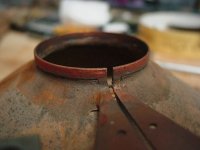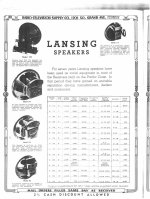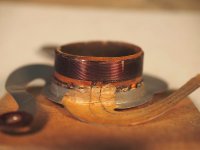Feel the burn, drive-by naysayers 😎With the lowest level of total harmonic distortion (THD) ever measured in our anechoic chamber
Now you can.
Not likely to find place in sight
View attachment 1409929
Moreover, you need to pick up the two cabinets with the 13" woofer
Hello,
We are still in the "Experiments with current drive" thread. You still can not walk into Best Buy and purchase a current drive amplifier.
The Focal Utopia Main 112 amplifier is designed and built to operate with a specific set of proprietary speakers. The Focal speakers are designed for soffit installation, the amplifier is not. The amplifier requires more air flow for cooling than is available in a soffit, it is often in a remote control room rack.
I do agree that current drive is a thing. I even built a current drive amplifier to play with on my bench.
The more likely place we will see current drive principals applied is in the design of passive crossovers.
Current drive is still a novelty, less new than obscure. We are not going to see “current amplifiers” on the shelf at the hifi shop any time soon.
Thanks DT
What do you hear? Honest question Lars. I have never heard that commented on any of the underhung designs that I have done for many years.The Barkhausen noise can be plainly audible when sweeping - heard it on underhung woofers (a lot of iron around the coil).
The more likely place we will see current drive principals applied is in the design of passive crossovers.
Yep, it definitely has impact on my xover design patterns: Edelstoff
Also on active systems: I put coils and notches in series of active driven channels to lowpass / EQ the distortion profile in the passband.
The Focal stuff comes under "Amps integrated with the speaker" There are better ways of doing this, some of which will give the advantages of current drive without the tweaking .. eg ACE base by AudioPro.
I've investigated many of these, including the two above, in my Powered Integrated Super Sub technology efforts . Patents Pending 😊
I've investigated many of these, including the two above, in my Powered Integrated Super Sub technology efforts . Patents Pending 😊
ACE-Bass basically is the opposite of current drive. Rather than decreasing (or even eliminating) the back-EMF effect, they use negative output impedance of the amplifier to increase it.some of which will give the advantages of current drive without the tweaking .. eg ACE base by AudioPro
Down low, for (sub-)woofer duty in a restricted frequency range this is perfectly fine, of course.
KSTR, yes but the results; lower THD bla bla, are the 'same' with the advantage of precise LF alignment. I'm not sure "increasing the back-EMF effect" is the proper description.
I have a Jurassic post on the subject to another forum. I'll see if I can find it.
The REAL problem is that no modern speaker is designed for current drive. Maybe the Focals are the first 😊
I tried to start a discussion on how to do this but no one was interested
I have a Jurassic post on the subject to another forum. I'll see if I can find it.
The REAL problem is that no modern speaker is designed for current drive. Maybe the Focals are the first 😊
I tried to start a discussion on how to do this but no one was interested

Agree totally. Infinite number of options between negative output impedance and high output impedance(current drive) exist."Voltage drive" and "current drive" are just two of the simplest embodiments of such profiles among an infinite set. People have to understand that it's not voltage drive vs current drive as if that were the only two options.
Most speaker cones have a rising response with frequency until breakup when in current drive. This is mostly consistent across drivers with the same cone diameter, although there are some drivers that behave differently. To make a simple to use driver for current drive, you have to roll off the acoustic gain of the cone somehow to compensate for the missing inductance effect. If this can be done by using a different cone material/design, then it would be a complete departure from the way cones are designed for voltage drive. Any attempt to do this by shorting out the coil flux results in motor distortions getting back into the the drive force.
Non est tantum facileMost speaker cones have a rising response with frequency until breakup when in current drive. This is mostly consistent across drivers with the same cone diameter, although there are some drivers that behave differently. To make a simple to use driver for current drive, you have to roll off the acoustic gain of the cone somehow to compensate for the missing inductance effect. If this can be done by using a different cone material/design, then it would be a complete departure from the way cones are designed for voltage drive.
The problem is much more fundamental than that.
To put this into perspective, the type of 'common' speaker most amenable to current drive is the Constant Charge Push Pull Electrostatic. I can see how to convert a QUAD ESL63 to perform better with a Current Drive Amp than with traditional Voltage amps.
I don't know an elegant way for a 'cone' type speaker to do the same.
That was partly my point, for a current drive cone speaker to be as easy to implement as a voltage drive cone speaker, something major has to change. Otherwise you have to commit to DSP or at least basic EQ on the amplifier.
I don't see good electrostatics being remotely affordable by me in the near future, so it never crossed my mind.
I don't see good electrostatics being remotely affordable by me in the near future, so it never crossed my mind.
If the frequency response is tilted, how is this a major failing? It could be beneficial to have a mild pre-emphasis on the treble, and set up the pre-amp to reverse the slope.
Anecdotally, most ordinary 8 ohm midwoofers are designed with an upper limit somewhere around 10-20 ohms at high frequencies, before they say "add a tweeter to avoid break-up". That's where increasing the output impedance can shine. The best way I find to visualise the main sources of distortion (as discussed by Klippel and others) is to think of it as a trimmable inductance for gain adjustment. It's built into the hardware, so how do you get rid of its negative influence? That's where current drive comes in. It's the equivalent 10 (on the low side) 100 or 1000 ohms in series, which makes the circa 1 ohm modulation far less relevant than relying on the speaker's measly ~6 ohm DC resistance to dilute the distortion.
A lot of speakers now have copper shorting rings, so people claim that they're designed to be driven with voltage control. No, that just makes it less bad. There's only so much shorting that can be done, before other practical limits are hit as well. Sensitivity goes down and mechanical damping gets skewed. And cone edge resonances misbehave. It's like permanently installing a rubber thumb that presses hard against the dustcap, while the sophisticated voice coil suspended in a magnetic field is foolishly (IMO) stuck on "apply the maximum electrical braking force achievable at all frequencies".
On the other hand, at low frequencies, as far as I can tell, most speakers really are designed for voltage drive, but I'm talking about a maximum of around ~300 or 500Hz for a 6.5" woofer. Where the inductive reactance is <1 ohm and total speaker impedance about 6-7 ohms, there's just no mechanism for current drive to fix anything. And in the bass, the motional impedance is dynamically generated only in response to cone velocity, causing impedances to appear in the magnetised mid-section of the voice coil.
Anecdotally, most ordinary 8 ohm midwoofers are designed with an upper limit somewhere around 10-20 ohms at high frequencies, before they say "add a tweeter to avoid break-up". That's where increasing the output impedance can shine. The best way I find to visualise the main sources of distortion (as discussed by Klippel and others) is to think of it as a trimmable inductance for gain adjustment. It's built into the hardware, so how do you get rid of its negative influence? That's where current drive comes in. It's the equivalent 10 (on the low side) 100 or 1000 ohms in series, which makes the circa 1 ohm modulation far less relevant than relying on the speaker's measly ~6 ohm DC resistance to dilute the distortion.
A lot of speakers now have copper shorting rings, so people claim that they're designed to be driven with voltage control. No, that just makes it less bad. There's only so much shorting that can be done, before other practical limits are hit as well. Sensitivity goes down and mechanical damping gets skewed. And cone edge resonances misbehave. It's like permanently installing a rubber thumb that presses hard against the dustcap, while the sophisticated voice coil suspended in a magnetic field is foolishly (IMO) stuck on "apply the maximum electrical braking force achievable at all frequencies".
On the other hand, at low frequencies, as far as I can tell, most speakers really are designed for voltage drive, but I'm talking about a maximum of around ~300 or 500Hz for a 6.5" woofer. Where the inductive reactance is <1 ohm and total speaker impedance about 6-7 ohms, there's just no mechanism for current drive to fix anything. And in the bass, the motional impedance is dynamically generated only in response to cone velocity, causing impedances to appear in the magnetised mid-section of the voice coil.
When you "set up the preamp to reverse the slope", that is extra complexity and specialization. No one will adopt a harder manufacturing process without increasing the price. Needing any drive EQ at all means that amplifiers are no longer universal, every current drive woofer now requires a specially tuned amp.
It's not obvious to me that the effects you describe for a shorting ring are observable in available woofers. The braking force of an energized voicecoil is highly nonlinear and would appear as intermodulation and 3rd harmonic that rise steeply with level. We rarely see a 3rd harmonic in the inductance dominated band that doesn't closely follow the pattern of hysteresis unless it occurs at an obvious vibration mode. The damping of a slit aluminum former is known but I haven't seen anything that shows a level-responsive 3rd harmonic caused by a shorting ring that was unrelated to Xmax.
The shorting ring holds the motor flux more constant which reduces hysteresis and inductance modulation with current, and with good geometry can reduce intermodulation. It is still beneficial even in current drive unless the nonlinear braking distortion can actually be observed in operation.
It's not obvious to me that the effects you describe for a shorting ring are observable in available woofers. The braking force of an energized voicecoil is highly nonlinear and would appear as intermodulation and 3rd harmonic that rise steeply with level. We rarely see a 3rd harmonic in the inductance dominated band that doesn't closely follow the pattern of hysteresis unless it occurs at an obvious vibration mode. The damping of a slit aluminum former is known but I haven't seen anything that shows a level-responsive 3rd harmonic caused by a shorting ring that was unrelated to Xmax.
The shorting ring holds the motor flux more constant which reduces hysteresis and inductance modulation with current, and with good geometry can reduce intermodulation. It is still beneficial even in current drive unless the nonlinear braking distortion can actually be observed in operation.
Yup.The shorting ring holds the motor flux more constant which reduces hysteresis and inductance modulation with current, and with good geometry can reduce intermodulation. It is still beneficial even in current drive unless the nonlinear braking distortion can actually be observed in operation.
Does anyone mention that current drive is what happens in a loudspeaker motor anyway? I understand the concept on both sides. First read about this concept in an AES paper by Martin Colloms when he was at Celestion in the late 80's trying this. But the drivers were custom wound with coils that took advantage of the concept. This is what is missing in the application of current drive. Tailored drivers for current drive.
I assume the low impedances we see commonly on speakers originated from the automobile industry. Off mains, we can get all the voltage we want, but that's traditionally harder to do in a car. Seems speaker VC impedances are as stuck on numbers like 4 and 8, as the commercial amplifier industry is stuck on low voltage, high current designs. Outside of crafting your own drivers / VCs...most of the choices are squarely in the voltage drive camp, for fear of losing their shirt should they dare to deviate.Tailored drivers for current drive.
It's almost like an off brand manufacturer of electric guitars - what two copies must they make, if they are to have any hope of staying afloat? A Strat and a Tele - almost like "4" and "8".
So you have to work with what's available. These days I assume most things have DSP, so there's no additional manufacturing cost in adding in some compensating eq - you have to load it with some code anyway, before its a working product.
Interesting how current drive is a natural on electrostatics, if you just look from the amplifier or matching transformer perspective. One time Acoustat owner, with the direct drive amps and their 4kV B+ power supplies. I had one of those TV anode sticks to measure that.
When you increase the coil turns, you increase the MMF and inductance at the same time as you increase resistance, so changing the speaker impedance is not an effective way to gain similar benefits to current drive.
At the impedance minimum around 300Hz, MMF and inductance are small relative to Re, so can be considered current drive even if you're using a voltage amp, and this is also where woofer distortion is usually lowest on sweeps. This is also where many speakers have too little output because Re+Rseries is too high.
MMF is also usually small relative to inductance at higher frequencies, so could be said to be current driven, except that the drive current is nonlinear because of inductance modulation.
Does anyone mention that current drive is what happens in a loudspeaker motor anyway?
At the impedance minimum around 300Hz, MMF and inductance are small relative to Re, so can be considered current drive even if you're using a voltage amp, and this is also where woofer distortion is usually lowest on sweeps. This is also where many speakers have too little output because Re+Rseries is too high.
MMF is also usually small relative to inductance at higher frequencies, so could be said to be current driven, except that the drive current is nonlinear because of inductance modulation.
Still have that paper?First read about this concept in an AES paper by Martin Colloms when he was at Celestion in the late 80's trying this. But the drivers were custom wound with coils that took advantage of the concept.
Not so sure about that. Here's a photo of the voice coil of an old Western Electric loudspeaker, supposedly circa 1923 (source):I assume the low impedances we see commonly on speakers originated from the automobile industry.

Solid copper ring. A dead short, essentially.
Here's an Lansing Manufacturing Co. advertisement from 1934 (source):

The voice coil DCR specs are all less than 3Ω, except for the 15" models which are 12Ω. Here's the voice coil of a late 1920s Jensen D4 (source):

Apparently around 6Ω DCR.
- Home
- Loudspeakers
- Multi-Way
- Experiments with the current drive